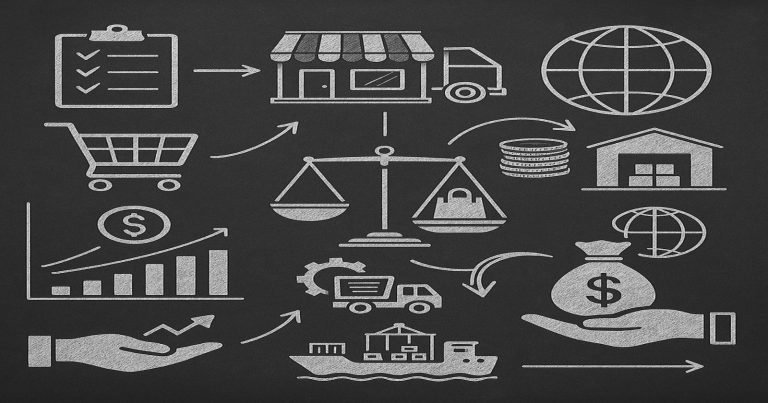People often get confused between trade and commerce. They use these words as if they mean the same. But they do not. Businesses depend on both, and both play different roles. The difference between trade and commerce lies in their meaning, scope, function, and use. Trade means buying and selling goods. Commerce means all the activities that help trade happen smoothly. Trade only talks about the exchange of goods. Commerce covers transport, banking, insurance, and storage that support trade. Knowing this difference helps students, shopkeepers, and business owners understand their work better and grow faster.
What is Trade?
Trade is one of the oldest forms of economic activity. It is the basis of all business. Trade happens when two people or two companies exchange goods or services. The aim is to earn a profit. Trade occurs in markets, shops, online websites, and countries. A trader brings goods from one place and sells them in another. Both sides get what they need.
Types of Trade
Trade happens in different forms. Each type of trade needs good planning. Traders study prices, demand, and transport options. They make deals and try to make a profit. The main types are:
- Internal Trade: People do trade within the same country. A seller in Delhi sells goods to a buyer in Mumbai. This is called domestic or internal trade.
- External Trade: When goods cross borders, the trade becomes international. A seller in India sells to someone in the USA. That is foreign trade.
Role of Traders
Traders play a key role in business. They act as a link between producers and customers. Producers cannot sell directly to everyone. Traders make it easy. They bring goods from factories and sell them to people. They take risks and invest money. Traders create a supply chain that makes goods reach the right place on time.
Trade Needs Support
Trade cannot work alone. It needs help from many services. Transport moves goods. Banks give money. Insurance covers risks. Warehouses store items. All these things are not trade. But they help with trade work. These services are part of commerce. So, trade is a part of commerce. But commerce is much bigger.
What is Commerce?
Commerce includes all the activities that support trade. It makes trade possible. It helps move goods from one place to another. It connects producers with customers. Commerce covers transport, banking, insurance, advertising, warehousing, and communication. Commerce starts after goods are produced and ends when they reach the customer. Commerce builds a link between the place of production and the place of need.
Scope of Commerce
Commerce includes two parts. They are trade and aids to trade. Together, they make sure that goods move without any trouble. Aids to trade are services that help trade work well.
- Transport: Helps goods move from factories to markets.
- Banking: Gives money to buy or sell goods.
- Insurance: Covers loss or damage during the movement of goods.
- Warehousing: Stores goods before they are sold.
- Advertising: Tells customers about the goods.
All these make commerce a wide and strong system. Without commerce, trade cannot work smoothly. Goods may not reach the market. People may not know what to buy. So, commerce plays a significant role in running a business.
Role of Commerce in Business
Commerce makes businesses grow. It gives a support system that removes all hurdles. When a company wants to sell its product, commerce helps in all steps. From storing goods to telling people about the product, commerce manages everything. Business houses use commerce to plan sales, reach customers, and collect payments.
Commerce Creates Jobs
Many people get jobs through commerce. Drivers, bankers, salespeople, warehouse staff, and ad designers all work in commerce. Commerce creates business for service industries. It opens doors for small and large companies. It keeps money moving in the economy. That is why commerce is called the lifeline of trade and business.
Difference Between Trade and Commerce in Detail
Both trade and commerce deal with goods and services. But their work, purpose, and use are not the same. The difference between trade and commerce becomes clear when we study their scope, need, and system. Trade talks only about the act of buying and selling. Commerce includes all the steps and services that support the act.
| Factor | Trade | Commerce |
| Meaning | Buying and selling of goods | Services that help in trade |
| Scope | Narrow | Wide |
| Purpose | Exchange of goods and making a profit | Support trade and ease business flow |
| Types | Internal, External | Trade, Aids to trade |
| Examples | A shopkeeper selling clothes | Transport, Banking, Insurance, Warehousing |
Purpose and Function
Trade focuses on selling goods. A trader brings items from one place and sells them. They aim to make a profit through buying and selling. They do not provide extra services. On the other hand, commerce does not sell goods. It supports those who sell. It makes the selling process easy, fast, and safe. A bank gives money to the trader. A truck takes the goods to the shop. An ad informs the buyer. All this is commerce.
Scope and Area of Work
Trade works on a small part of the business. It only looks at the exchange. Commerce takes care of the whole system. It starts where production ends. It ends where the customer gets the product. So, commerce covers more area than trade. This clearly shows the difference between business commerce and trade.
Need and Use
People can trade without much help. But they cannot grow trade without commerce. Commerce builds the tools that trade needs. A trader cannot sell to 100 cities without transport. They cannot take risks without insurance. So, there is a need for commerce in modern business.
Difference Between Trade and Commerce FAQs
1. What is the difference between trade and commerce?
The difference between trade and commerce is that trade means buying and selling goods. Commerce means supporting services like transport, banking, and warehousing that help trade happen smoothly.
2. How does commerce help in trade?
Commerce supports trade by offering transport, banking, insurance, and storage. These services help in moving goods safely and quickly to customers.
3. What is the difference between business commerce and trade?
Business includes trade, commerce, and industry. Trade only involves selling. Commerce covers all tools needed for trade. Business consists of both and more.
4. Can trade work without commerce?
Small trade may happen without full commerce. But large trade always needs support. Commerce gives that support through different services.
5. What is the role of commerce in business growth?
Commerce helps businesses grow by improving sales, reducing risks, and making goods reach far places. It connects producers and buyers across regions.


